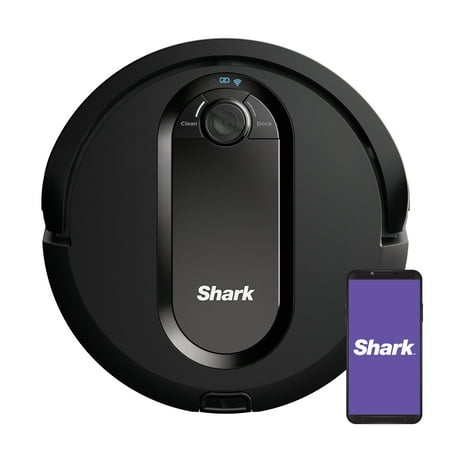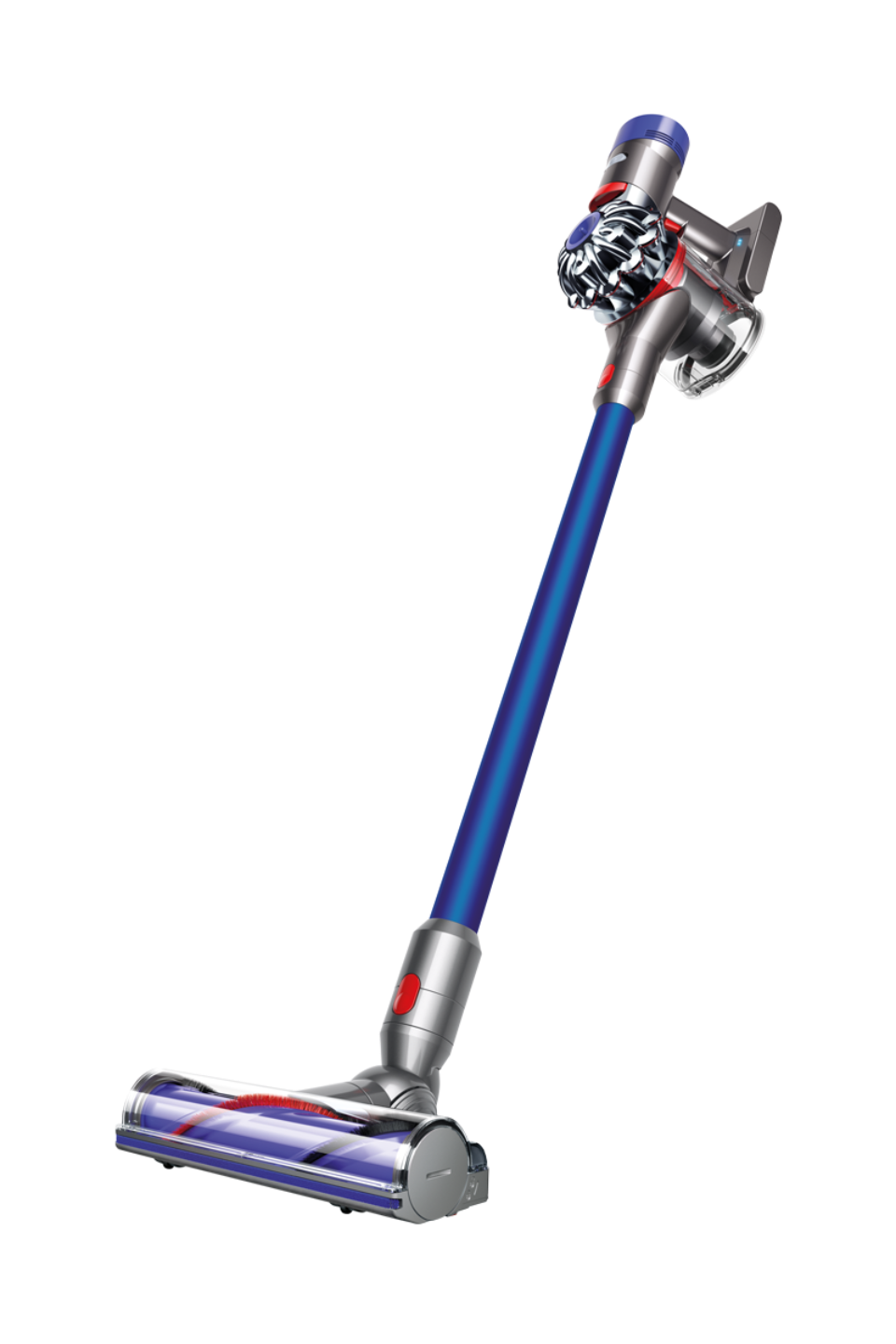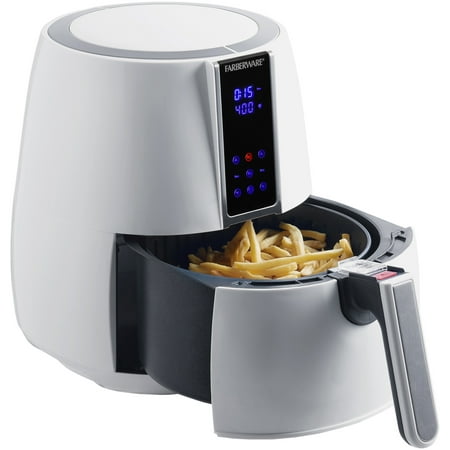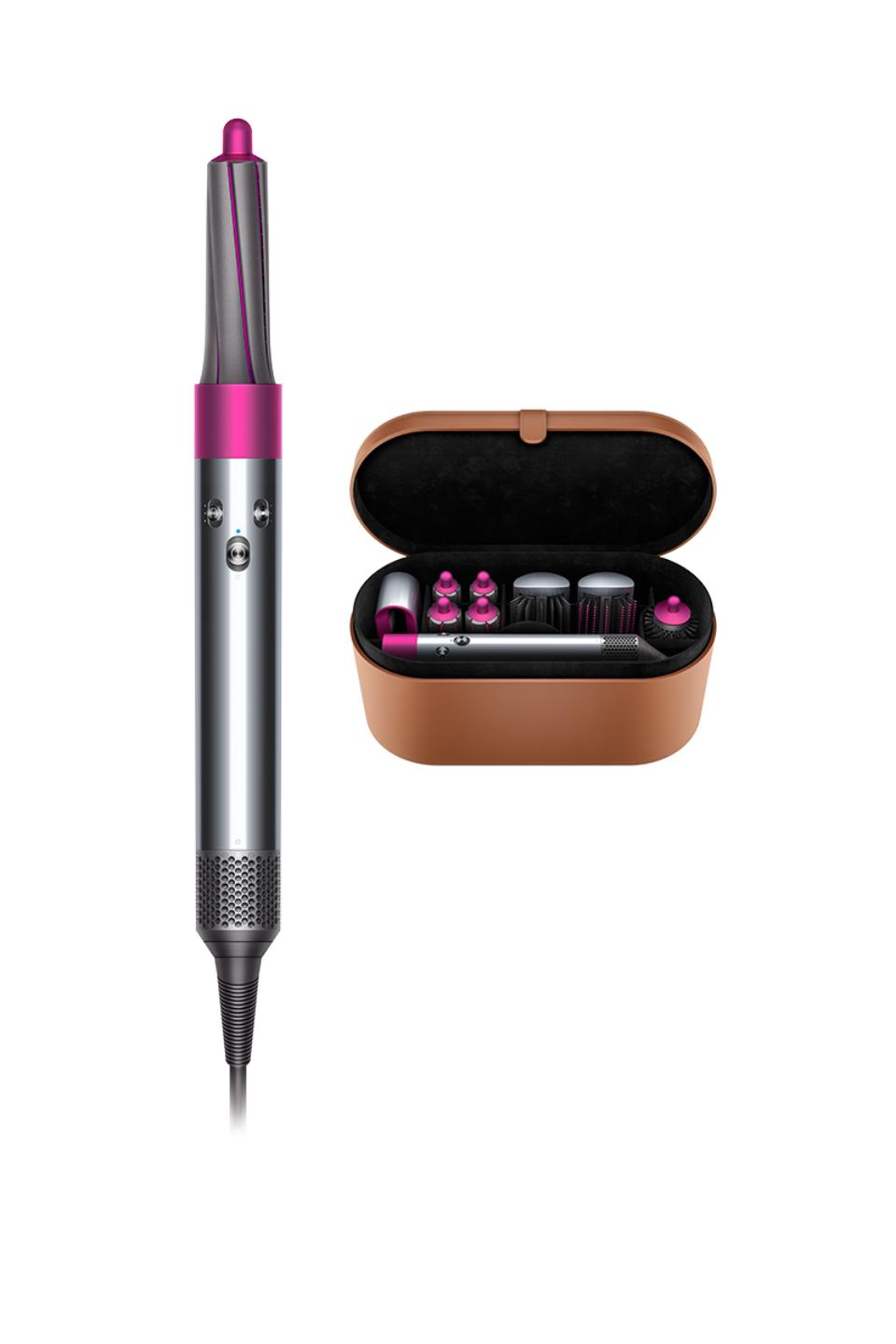Shark IQ Robot® Vacuum, Self Cleaning Brushroll, Advanced Navigation, Home Mapping, Powerful Suction, Perfect for Pet Hair, Wi-Fi (RV1000)
Powered by IQ Navigation™, the Shark IQ Robot® vacuum maps your whole home, allowing you to select which rooms to clean immediately with the SharkClean ™ app. Methodically cleans row by row and navigates to room to room for complete home coverage. Features Shark® powerful suction and self cleaning brushroll for no more hair wrap. Give your home a constant state of clean carpets and floors.
-
Dyson V7 Motorhead Origin Vacuum
Rated 4.88 out of 508Dyson V7 Motorhead Origin Vacuum
Rated 4.88 out of 508 -
Dyson Airwrap™ Complete (Nickel/Fuchsia)
Rated 5.00 out of 511Dyson Airwrap™ Complete (Nickel/Fuchsia)
Rated 5.00 out of 511











Shark IQ Robot Vacuum R100, Wi-Fi Connected, Home Mapping (RV1000):INCREDIBLE SUCTION: Deep-cleaning power to take on large debris, small debris, and pet hair on carpets and floorsNO HAIR WRAP: Self-cleaning brushroll pulls in all types of hair on all surfaces without letting it wrap on the brushrollPHONE OR VOICE COMMAND: Schedule whole-home cleanings or target specific rooms or areas to clean right now with the SharkClean app or voice control with Amazon Alexa or Google AssistantTOTAL HOME MAPPING + ROOM SELECT: Maps your home and lets you choose which rooms to clean right nowROW-BY-ROW CLEANING: Methodically cleans row by row and then navigates room to room for complete home coverageRECHARGE AND RESUME: The Shark IQ Robot vacuum will return to the dock, recharge, and can pick up where it left offPERFECT FOR PETS: Designed for homes with pets, this automatic vacuum features a XL dust cup, a self-cleaning brushroll, and a high-efficiency filter to capture dust, dander, and pet allergensHIGH-EFFICIENCY FILTER: Captures and traps 99% of dust, dander, and pet allergens*. (*down to 1 micron)
Cleaning is the process of removing unwanted substances, such as dirt, infectious agents, and other impurities, from an object or environment. Cleaning is often performed for aesthetic, hygienic, functional, safety, or environmental protection purposes. Cleaning occurs in many different contexts, and uses many different methods. Several occupations are devoted to cleaning.
Hair is a protein filament that grows from follicles found in the dermis. Hair is one of the defining characteristics of mammals. The human body, apart from areas of glabrous skin, is covered in follicles which produce thick terminal and fine vellus hair. Most common interest in hair is focused on hair growth, hair types, and hair care, but hair is also an important biomaterial primarily composed of protein, notably alpha-keratin.
Attitudes towards different forms of hair, such as hairstyles and hair removal, vary widely across different cultures and historical periods, but it is often used to indicate a person's personal beliefs or social position, such as their age, gender, or religion.
A home, or domicile, is a space used as a permanent or semi-permanent residence for one or more human occupants, and sometimes various companion animals. It is a fully- or semi-sheltered space and can have both interior and exterior aspects to it. Homes provide sheltered spaces, for instance rooms, where domestic activity can be performed such as sleeping, preparing food, eating and hygiene as well as providing spaces for work and leisure such as remote working, studying and playing.
Physical forms of homes can be static such as a house or an apartment, mobile such as a houseboat, trailer or yurt or digital such as virtual space. The aspect of 'home' can be considered across scales; from the micro scale showcasing the most intimate spaces of the individual dwelling and direct surrounding area to the macro scale of the geographic area such as town, village, city, country or planet.
The concept of 'home' has been researched and theorized across disciplines – topics ranging from the idea of home, the interior, the psyche, liminal space, contested space to gender and politics. The home as a concept expands beyond residence as contemporary lifestyles and technological advances redefine the way the global population lives and works. The concept and experience encompasses the likes of exile, yearning, belonging, homesickness and homelessness.
Mapping may refer to:
- Cartography, the process of making a map
- Mapping (mathematics), a synonym for a mathematical function and its generalizations
- Mapping (logic), a synonym for functional predicate
Navigation is a field of study that focuses on the process of monitoring and controlling the movement of a craft or vehicle from one place to another. The field of navigation includes four general categories: land navigation, marine navigation, aeronautic navigation, and space navigation. It is also the term of art used for the specialized knowledge used by navigators to perform navigation tasks. All navigational techniques involve locating the navigator's position compared to known locations or patterns. Navigation, in a broader sense, can refer to any skill or study that involves the determination of position and direction. In this sense, navigation includes orienteering and pedestrian navigation.
For marine navigation, this involves the safe movement of ships, boats and other nautical craft either on or underneath the water using positions from navigation equipment with appropriate nautical charts (electronic and paper). Navigation equipment for ships is mandated under the requirements of the SOLAS Convention, depending on ship size. For land navigation, this involves the movement of persons, animals and vehicles from one place to another by means of navigation equipment (such as a compass or GNSS receivers), maps and visual navigation marks across urban or rural environments. Aeronautic (air) navigation involves piloting an aircraft from one geographic position to another position while monitoring the position as the flight progresses.
Perfect commonly refers to:
- Perfection; completeness, and excellence
- Perfect (grammar), a grammatical category in some languages
Perfect may also refer to:
A pet, or companion animal, is an animal kept primarily for a person's company or entertainment rather than as a working animal, livestock, or a laboratory animal. Popular pets are often considered to have attractive/cute appearances, intelligence, and relatable personalities, but some pets may be taken in on an altruistic basis (such as a stray animal) and accepted by the owner regardless of these characteristics.
Two of the most popular pets are dogs and cats. Other animals commonly kept include rabbits; ferrets; pigs; rodents such as gerbils, hamsters, chinchillas, rats, mice, and guinea pigs; birds such as parrots, passerines, and fowls; reptiles such as turtles, lizards, snakes, and iguanas; aquatic pets such as fish, freshwater snails, and saltwater snails; amphibians such as frogs and salamanders; and arthropod pets such as tarantulas and hermit crabs. Smaller pets include rodents, while the equine and bovine group include the largest companion animals.
Pets provide their owners, or guardians, both physical and emotional benefits. Walking a dog can provide both the human and the dog with exercise, fresh air, and social interaction. Pets can give companionship to people who are living alone or elderly adults who do not have adequate social interaction with other people. There is a medically approved class of therapy animals that are brought to visit confined humans, such as children in hospitals or elders in nursing homes. Pet therapy utilizes trained animals and handlers to achieve specific physical, social, cognitive, or emotional goals with patients.
People most commonly get pets for companionship, to protect a home or property, or because of the perceived beauty or attractiveness of the animals. A 1994 Canadian study found that the most common reasons for not owning a pet were lack of ability to care for the pet when traveling (34.6%), lack of time (28.6%), and lack of suitable housing (28.3%), with dislike of pets being less common (19.6%). Some scholars, ethicists, and animal rights organizations have raised concerns over keeping pets because of the lack of autonomy and the objectification of non-human animals.
Powerful may refer to:
- HMS Powerful, four ship and two training establishments of the Royal Navy
- Powerful-class cruiser, a class of two Royal Navy protected cruisers
- Haakon Sigurdsson (c. 937–995), de facto ruler of Norway from about 975 to 995, sometimes called Haakon the Powerful
- Powerful (song), a 2015 song by Major Lazer
A robot is a machine—especially one programmable by a computer—capable of carrying out a complex series of actions automatically. A robot can be guided by an external control device, or the control may be embedded within. Robots may be constructed to evoke human form, but most robots are task-performing machines, designed with an emphasis on stark functionality, rather than expressive aesthetics.
Robots can be autonomous or semi-autonomous and range from humanoids such as Honda's Advanced Step in Innovative Mobility (ASIMO) and TOSY's TOSY Ping Pong Playing Robot (TOPIO) to industrial robots, medical operating robots, patient assist robots, dog therapy robots, collectively programmed swarm robots, UAV drones such as General Atomics MQ-1 Predator, and even microscopic nanorobots. By mimicking a lifelike appearance or automating movements, a robot may convey a sense of intelligence or thought of its own. Autonomous things are expected to proliferate in the future, with home robotics and the autonomous car as some of the main drivers.
The branch of technology that deals with the design, construction, operation, and application of robots, as well as computer systems for their control, sensory feedback, and information processing is robotics. These technologies deal with automated machines that can take the place of humans in dangerous environments or manufacturing processes, or resemble humans in appearance, behavior, or cognition. Many of today's robots are inspired by nature contributing to the field of bio-inspired robotics. These robots have also created a newer branch of robotics: soft robotics.
From the time of ancient civilization, there have been many accounts of user-configurable automated devices and even automata, resembling humans and other animals, such as animatronics, designed primarily as entertainment. As mechanical techniques developed through the Industrial age, there appeared more practical applications such as automated machines, remote-control and wireless remote-control.
The term comes from a Slavic root, robot-, with meanings associated with labor. The word "robot" was first used to denote a fictional humanoid in a 1920 Czech-language play R.U.R. (Rossumovi Univerzální Roboti – Rossum's Universal Robots) by Karel Čapek, though it was Karel's brother Josef Čapek who was the word's true inventor. Electronics evolved into the driving force of development with the advent of the first electronic autonomous robots created by William Grey Walter in Bristol, England in 1948, as well as Computer Numerical Control (CNC) machine tools in the late 1940s by John T. Parsons and Frank L. Stulen.
The first commercial, digital and programmable robot was built by George Devol in 1954 and was named the Unimate. It was sold to General Motors in 1961 where it was used to lift pieces of hot metal from die casting machines at the Inland Fisher Guide Plant in the West Trenton section of Ewing Township, New Jersey.
Robots have replaced humans in performing repetitive and dangerous tasks which humans prefer not to do, or are unable to do because of size limitations, or which take place in extreme environments such as outer space or the bottom of the sea. There are concerns about the increasing use of robots and their role in society. Robots are blamed for rising technological unemployment as they replace workers in increasing numbers of functions. The use of robots in military combat raises ethical concerns. The possibilities of robot autonomy and potential repercussions have been addressed in fiction and may be a realistic concern in the future.
In philosophy, the self is an individual's own being, knowledge, and values, and the relationship between these attributes.
The first-person perspective distinguishes selfhood from personal identity. Whereas "identity" is (literally) sameness and may involve categorization and labeling, selfhood implies a first-person perspective and suggests potential uniqueness. Conversely, "person" is used as a third-person reference. Personal identity can be impaired in late-stage Alzheimer's disease and in other neurodegenerative diseases. Finally, the self is distinguishable from "others". Including the distinction between sameness and otherness, the self versus other is a research topic in contemporary philosophy and contemporary phenomenology (see also psychological phenomenology), psychology, psychiatry, neurology, and neuroscience.
Although subjective experience is central to selfhood, the privacy of this experience is only one of many problems in the philosophy of self and scientific study of consciousness.
Sharks are a group of elasmobranch cartilaginous fish characterized by a ribless endoskeleton, dermal denticles, five to seven gill slits on each side, and pectoral fins that are not fused to the head. Modern sharks are classified within the division Selachii (or Selachimorpha) and are the sister group to the Batoidea (rays and skates). Some sources extend the term "shark" as an informal category including extinct members of Chondrichthyes (cartilaginous fish) with a shark-like morphology, such as hybodonts. Shark-like chondrichthyans such as Cladoselache and Doliodus first appeared in the Devonian Period (419–359 million years), though some fossilized chondrichthyan-like scales are as old as the Late Ordovician (458–444 million years ago). The earliest confirmed modern sharks (selachimorphs) are known from the Early Jurassic around 200 million years ago, with the oldest known member being Agaleus, though records of true sharks may extend back as far as the Permian.
Sharks range in size from the small dwarf lanternshark (Etmopterus perryi), a deep sea species that is only 17 centimetres (6.7 in) in length, to the whale shark (Rhincodon typus), the largest fish in the world, which reaches approximately 12 metres (40 ft) in length. They are found in all seas and are common to depths up to 2,000 metres (6,600 ft). They generally do not live in freshwater, although there are a few known exceptions, such as the bull shark and the river sharks, which can be found in both seawater and freshwater, and the Ganges shark, which lives only in freshwater. Sharks have a covering of placoid scales (denticles) that protects the skin from damage and parasites in addition to improving their fluid dynamics. They have numerous sets of replaceable teeth.
Several shark species are apex predators, which are organisms that are at the top of their food chain with select examples including the bull shark, tiger shark, great white shark, mako sharks, thresher sharks and hammerhead sharks. Some sharks are filter-feeding planktivores, such as the whale shark and basking shark, which are among the largest fish ever lived.
Sharks are caught by humans for shark meat or shark fins. Many shark populations are threatened by human activities. Since 1970, shark populations have been reduced by 71%, mostly from overfishing and mutilating practice such as shark finning.
Suction is the day-to-day term for the movement of gases or liquids along a pressure gradient with the implication that the movement occurs because the lower pressure pulls the gas or liquid. However, the forces acting in this case do not originate from just the lower pressure side, but also from the side of the higher pressure, as a reaction to the pressure difference.
When the pressure in one part of a physical system is reduced relative to another, the fluid or gas in the higher pressure region will exert a force relative to the region of lowered pressure, referred to as pressure-gradient force. If all gas or fluid is removed the result is a perfect vacuum in which the pressure is zero. Hence, no negative pressure forces can be generated. Accordingly, from a physics point of view, the objects are not pulled but pushed.
A vacuum (pl.: vacuums or vacua) is space devoid of matter. The word is derived from the Latin adjective vacuus (neuter vacuum) meaning "vacant" or "void". An approximation to such vacuum is a region with a gaseous pressure much less than atmospheric pressure. Physicists often discuss ideal test results that would occur in a perfect vacuum, which they sometimes simply call "vacuum" or free space, and use the term partial vacuum to refer to an actual imperfect vacuum as one might have in a laboratory or in space. In engineering and applied physics on the other hand, vacuum refers to any space in which the pressure is considerably lower than atmospheric pressure. The Latin term in vacuo is used to describe an object that is surrounded by a vacuum.
The quality of a partial vacuum refers to how closely it approaches a perfect vacuum. Other things equal, lower gas pressure means higher-quality vacuum. For example, a typical vacuum cleaner produces enough suction to reduce air pressure by around 20%. But higher-quality vacuums are possible. Ultra-high vacuum chambers, common in chemistry, physics, and engineering, operate below one trillionth (10−12) of atmospheric pressure (100 nPa), and can reach around 100 particles/cm3. Outer space is an even higher-quality vacuum, with the equivalent of just a few hydrogen atoms per cubic meter on average in intergalactic space.
Vacuum has been a frequent topic of philosophical debate since ancient Greek times, but was not studied empirically until the 17th century. Clemens Timpler (1605) philosophized about the experimental possibility of producing a vacuum in small tubes. Evangelista Torricelli produced the first laboratory vacuum in 1643, and other experimental techniques were developed as a result of his theories of atmospheric pressure. A Torricellian vacuum is created by filling with mercury a tall glass container closed at one end, and then inverting it in a bowl to contain the mercury (see below).
Vacuum became a valuable industrial tool in the 20th century with the introduction of incandescent light bulbs and vacuum tubes, and a wide array of vacuum technologies has since become available. The development of human spaceflight has raised interest in the impact of vacuum on human health, and on life forms in general.





Reviews
There are no reviews yet.